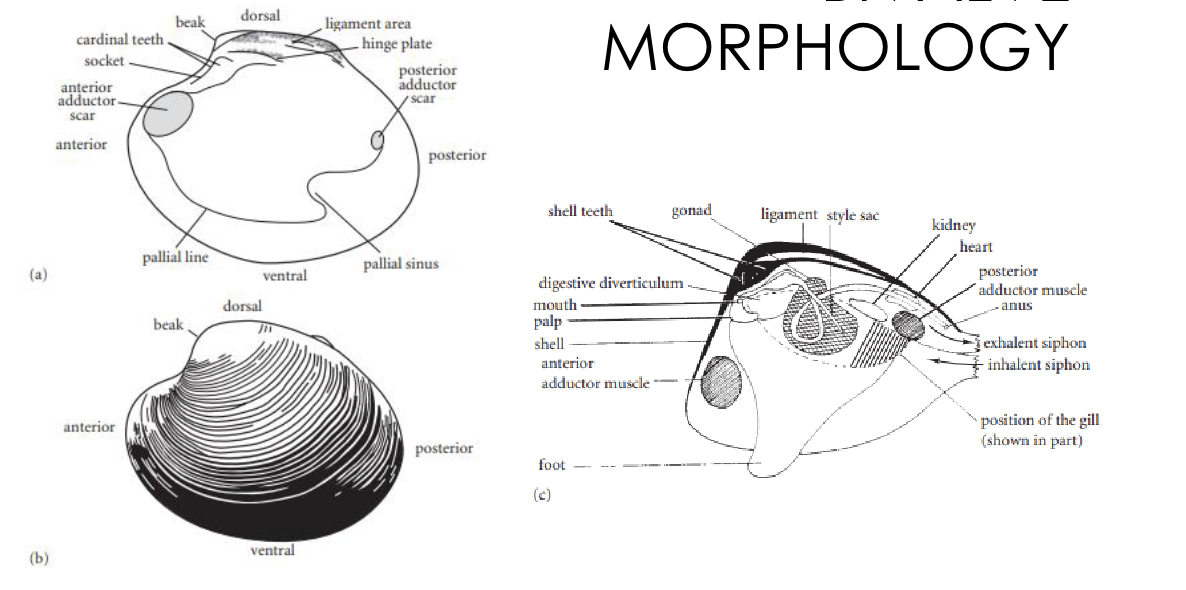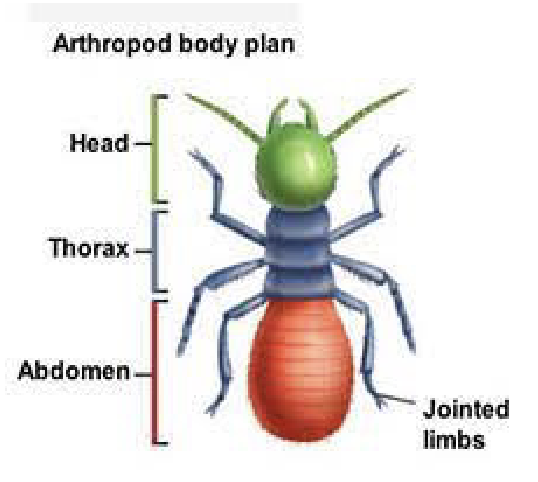Paleontology Exam 3
1/64
There's no tags or description
Looks like no tags are added yet.
Name | Mastery | Learn | Test | Matching | Spaced |
|---|
No study sessions yet.
65 Terms
Phylum Mollusca
second largest animal phylum, most common marine animals today.
Includes slugs, snails, squids, cuttlefish, octopus, clams, mussels, oysters
unsegmented, soft-bodied animals
live in marine, freshwater, and terrestrial habitats
highly diverse
Mollusk Body Plan Features
Radula: rasping feeding organ, composed of chitin and designed to scrape and drill
Foot: sole-like structure on which the animal crawls, but is very modified usually
Visceral mass: internal digestive, excretory, reproductive, and circulatory organs enclosed in the celomic cavity
Mantle: sheet of tissue lying dorsally over the visceral mass that is responsible for secreting the shell
Mollusk Shells
mollusk shells are secreted as calcium carbonate, mainly aragonite
3 Classes of Mollusk
Bivalvia, Gastropoda, Cephalopoda
Bivalvia
consisting of two hinged parts/valves
includes clams, oysters, mussels, scallops, etc
majority are filter feeders
shells are composed of calcium carbonate
typically bilaterally symmetrical
pearls are a valuable byproduct
Bivalve Morphology
important ones to remember: dorsal v ventral, adductor muscles, foot, beak, siphon

Bivalve Classification
based primarily on gill structure
protobranch, filibranch, eulamellibranch, septibranch
Bivalve Life Modes
a) shallow and deep burrowers into soft to firm substrates
b) epifaunal swimming, attached, or resting on soft to firm substrates
c) boring into hard substrates
Bivalve Reproduction
sexual reproduction, separate sexes
external fertilization — sperm and egg released into the water
larva hatches and develops in the water
History of the Bivalve
Early Cambrian to recent
they were hit hard by the Permian-Triassic extinction but didn’t reestablish themselves like the brachiopods
being able to burrow may have been a major factor in their success
Bivalve vs. Brachiopod
superficially resemble brachiopods
Bivalvia valves are mirror images of each other
brachiopod valve made up of calcium phosphate and carbonate, while bivalves are just calcium carbonate
Gastropoda
stomach foot
snails and slugs
Gastropod Life Modes
mostly benthic
have adapted to almost every marine environment
creeping, floating, free-swimming
feeding: grazing, predatory, or parasitic
Gastropod Reproduction
separate sexes or hermaphroditic
reproductive modes are highly diverse
most gastropods have internal fertilization, but some are external
Torsion
the rotation of the visceral mass, mantle, and shell 180 degrees with respect to the head and the foot
most gastropods have torsion
mantle cavity, gills, anus, excretory and reproductive openings come to lie above the head
advantages of this arrangement are unclear, torsion seems to be distinctly disadvantageous
coiling of the shell is unrelated to the rotation of the soft parts
Gastropod Shell
usually composed of aragonite
usually conical in shape
whorl: each revolution of the shell
spire: whorls comprised together
columella: central pillar caused by tight coiling about the vertical axis
also know suture, operculum, aperture
normally oriented with the aperture (opening) facing forward and the apex facing upwards
if the aperture is on the right-handside, the shell is coiled clockwise in dextral mode, while sinistral shells have opposite sense of coiling
shell surface is commonly modified by strong growth lines, ribs, tubercles
variety of shell shapes (patelliform, convolute, discoidal, biconical, digitate, turbinate, turreted, pupiform)
Limpet
group of aquatic snails that exhibit a conical shell shape and a strong, muscular foot
patelliform
Gastropod Classification
divided into 3 subclasses largely based on information from their soft parts
traditionally defined based on the radula and their respiratory and nervous systems
Prosobranchia, Opisthobranchia, Pulmonata
Prosobranchia
mostly marine
fully torted with one or two gills, an anteriro mantle cavity and cap-shaded or consipiral shells
euomphalus, patella, turritella
Opistobrachia
untorted with the shell reduced or absent and the mantle cavity posterior or absent
untorsion: they have gone through torsion followed by detorsion
pteropods: wing-foot, specialized free swimming pelagic sea snails
sea slugs: unshelled snail
Pulmonata
untorted with the mantle cavity modified as an air-breathing lung, and the shells are usually conspiral
lived in terrestrial environments
Gastropod Evolution
no general agreement on the origin of gastropods
it is thought to have been derived from a monoplacophoran-type (bearing one plate) ancestor by torsion and development of an exogastric condition
Cephalopod
head footed
examples are cuttlefish, squids, octopus
they are named because their head is situated directly on top of the foot — the foot is divided into tentacles
most complex mollusks
mantle encloses everything except head and tentacles, and acts as pump to bring large quantities of water into the cavity
Cephalopod Anatomy
exclusively marine
prominent head
arms for feeding, propulsion, reproduction
many can expel ink to discourage predators
very well developed eyes
gills for respiration
jet propulsion by squeezing body together quickly
bilateral symmetry
Cephalopod Habitat
benthic
highly motile
live on seafloor
have adapted to almost every marine environment
Cephalopod Feeding
most are predators using arms, tentacles, suckers to capture then their beaks rip prey apart
Cephalopod Reproduction
separate sexes
distinct egg cases
many types die after reproduction, mostly only living 1-2 years
Cephalopod Evolution
cambrian to present
cephalopods also though to be have been derived from the “bearing one plate” ancestor
early cephalopods likely predators near the top of the food chain
most ancient varieties had protective shells, which were at first conical but developed in to nautiloid
competition with fish is thought to have forced cephalopods into deeper water, pressuring them to lose their shells
Ammonoidea
ammonites
group of extinct mollusks
more closely related to living octopus, squids, and cuttlefish
Nautilus
easily visible foot, divided into many tentacles
leathery cover that works somewhat like an operculum, closing the aperture when the animal is at rest or in danger
Squids and Cuttlefish
earliest cuttlefish from cretaceous
earliest squids from devonian
squids and cuttlefish have an internal shell that is made of 3 layers with gas-filled spaces between each layer, helps with buoyancy
Octopus
eight arms, all with powerful suckers
good eye sight
eyes are elevated and capable of excellent vision in the dark
suckers on the ventral surface of arms are used to grip and capture food
Arthropoda
joint + foot or leg
lobsters, spiders, beetles, trilobites, etc
common and very diverse, accounts for a majority of all species today
adapted to marine and terrestrial environments
several arthropod-like animals in Ediacara biota suggest an ancient origin for Arthropoda
Arthropod Body Plan
segmented body plan
jointed appendages
hard external skeleton
3 parts - head, thorax, and abdomen
exoskeleton is hard, made of chitin
bilateral symmetry

Molting
shed old exoskeleton and secrete a larger one, very vulnerable after molting
Arthropod Anatomy
complete digestive tract with a dorsal heart and a ventral nervous system
mandible for chewing and proboscis for sucking
respiration through gills, trachea, book lungs, or body surface
sensory organs include antennae and hairs, simple and compound eyes
Compound Eye
has many lenses for increased eye sight for arthropods
they bulge out for more surface area and able to expand field of vision
Arthropoda Sub Phylums
trilobitomorpha: trilobites
chelicerata: spiders, horseshoe crabs, scorpions
myriapoda: centipedes, millipedes
crustacea: shrimp, lobsters
hexapoda: insects
Sub Phylum Crustacea
shrimps, crabs, lobsters, barnacles, pill bugs
two pairs of antennae
mandibles for chewing
pair of appendages on each body segment
gills for oxygenand a hard exoskeleton for protection.
Sub Phylum Chelicerata
horseshoe crabs, spiders, mites, scorpions
pincer-like appendages
small pinchers to venomous fangs
eurypterids, NY state fossil
Sub Phylum Myripoda
flexible centipedes and millipedes
first animals to colonize the land
came through the late Carboniferous forests
Sub Phylum Hexapoda
insects
highly diverse group, divided into two groups
pterygotes: wings
apterygotes: without wings
ants, beetles, dragonflies, flies, cockroaches, wasps
developed coevolutionary relationships with plants, especially between flowering plants
Sub Phylum Trilobitomorpha
trilobites
lack specialized mouthparts
some of the earliest arthropods
exoskeleton is divided into three lobes
axial lobe protects digestive system
two pleural lobes cover appendages
it is composed of calcite
grows by molting
morphology greatly varied and have a broad range of adaptations
benthic, leaving tracks in marine sediments
diet of microscopic organisms
Trilobite Abnormalities and Injuries
since there are many trilobite fossils, we can learn a lot about them
abnormalities:
injuries sustained during molting
pathological conditions resulting fro disease or infection
teratological effects arising from embryological or genetic malfunctions
many fossils show signs of predation that show an asymmetric distribution
predation scars are 3x as likely to be present on the right side
could indicate a lateralization of nervous system OR
scarred specimens were survivors and predators preferred to attack the left side and we never see those victims
Trace fossils
the product of an organism interacting with a substrate in an environment that generates a three-dimensional physical structure
Ichnology
study of trace fossils / a powerful tool for understanding past sedimentary environments and one of the major clues to the behavior of animals
What do trace fossils give evidence about?
the behavior of organisms
sedimentary environments
What can cause trace fossils?
dwelling, feeding, crawling, hiding, resting, grazing, cultivating, reproducing, escaping
Examples of trace fossils
burrows, footprints, boreholes, bite marks, feeding
Facts about trace fossils
most traces are largely facies dependent
no secondary displacement or transport
trace fossils are common in rocks that are otherwise unfossiliferous
non-preservation of the causative organism
3 Principles of Ichnology
the same individual can produce different structures corresponding to different behavior
identical structures may be produced by the activity of systematically different organisms where behavior is similar
the same individual may produce different structures corresponding with identical behavior but in different substrates
abundance
one animal, especially if mobile, can make many traces during its lifetime, whereas it may or may not have its body preserved in the fossil record
Facts about trace fossil preservation
preserved in rocks where body fossils are rare
diagenesis (heat and pressure) may destroy body fossils but has little effect on trace fossils
not subject to post-mortem transport, are automatically in situ
Types of trace fossil preservation
full relief: 3 dimensional relief, all sides of the trace exposed
semi relief: concave troughs or depressions on the top or bottom surface of a bed
epirelief: top trail on the surface
hyporelief: traces on the underside of the underlying bed
semireliefs are easier to understand and get information
Trace fossil morphological classification
tracks/trails on bedding plane
radially symmetrical horizontal markings
tunnels and shafts
arbitrary and not objective
Classifications of Trace Fossils
morphological and preservational
behavioral
phylogenetic
Repichnia
locomotion or crawling traces
tracks of moving surface dwellers
usually continuous
Cubichnia
resting traces
impressions caused when the animal interrupted its locomotion for rest and refuge
often reflects the anatomy of the undersurface of the organism
Pascichnia
grazing or surface feeder traces
series of parallel loops demonstrates a feeder moving along the sediment surface to eat bacteria
Fodinichnia
feeding traces/burrows
excavations made my deposits feeders, eating the sediment to digest the food within it
can be simple or complex branched
Domichnia
dwelling traces/structures
permanent burrows and borings of suspension feeders
can be subcylindrical tubes or u-shaped
Fugichnia
escape structures
showing signs of forced escape
animal digs out to escape or digs burrow upward to continue suspension feeding
What are trace fossils used to understand?
distribution and activity of organisms
depositional energy
sedimentation rate
oxygenation of bottom water and the substrate (defined by the amount of sediment reworking by burrowing organisms)
Importance of trace fossils in geology
long time range: similar taxa occur in present day environments
narrow facies range: certain traces are found in close association with certain substrates
no reworking: traces are a part of the rock, so they are destroyed by erosion rather than reworked like body fossils
occurrence in nonfossiliferous rocks: good for studies in hostile rock and poorly population environments
creation by soft-bodied taxa: trace fossils can give info about organisms that are not found in the fossil record
burrows and trails can help distinguish if sedimentary beds have been overturned
observing burrows that were circular cross-sections can determine stress that rocks have undergone